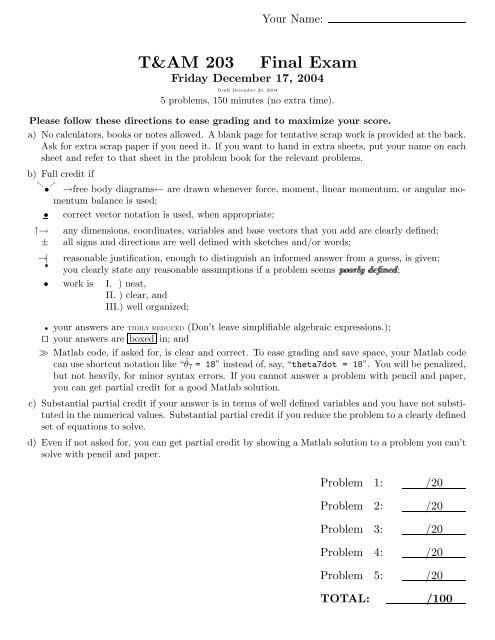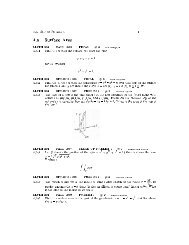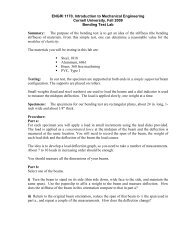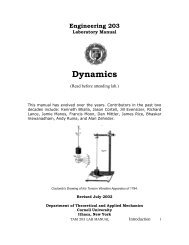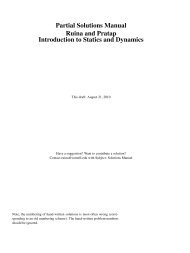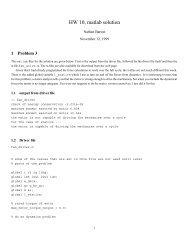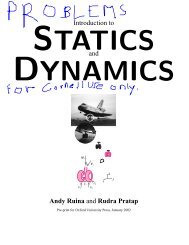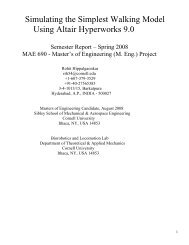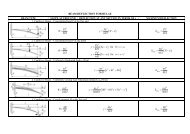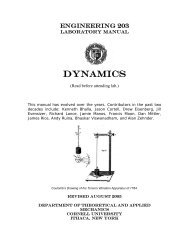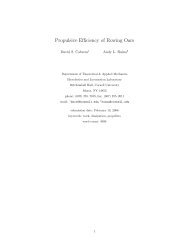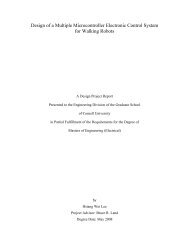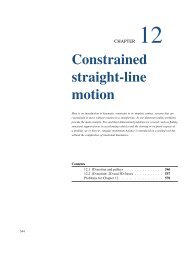You also want an ePaper? Increase the reach of your titles
YUMPU automatically turns print PDFs into web optimized ePapers that Google loves.
Your Name:T&<strong>AM</strong> <strong>203</strong><strong>Final</strong> <strong>Exam</strong>Friday December 17, 2004Draft December 20, 20045 problems, 150 minutes (no extra time).Please follow these directions to ease grading and to maximize your score.a) No calculators, books or notes allowed. A blank page for tentative scrap work is provided at the back.Ask for extra scrap paper if you need it. If you want to hand in extra sheets, put your name on eachsheet and refer to that sheet in the problem book for the relevant problems.b) Full credit ifտ• ր→free body diagrams← are drawn whenever force, moment, linear momentum, or angular momentumbalance is used;• correct vector notation is used, when appropriate;↑→ any dimensions, coordinates, variables and base vectors that you add are clearly defined;± all signs and directions are well defined with sketches and/or words;→| reasonable justification, enough to distinguish an informed answer from a guess, is given;you clearly state any reasonable assumptions if a problem seems poorly defined;• work is I. ) neat,II. ) clear, andIII.) well organized;• your answers are TIDILY REDUCED (Don’t leave simplifiable algebraic expressions.);⊓⊔ your answers are boxed in; and≫ Matlab code, if asked for, is clear and correct. To ease grading and save space, your Matlab codecan use shortcut notation like “ ˙θ 7 = 18” instead of, say, “theta7dot = 18”. You will be penalized,but not heavily, for minor syntax errors. If you cannot answer a problem with pencil and paper,you can get partial credit for a good Matlab solution.c) Substantial partial credit if your answer is in terms of well defined variables and you have not substitutedin the numerical values. Substantial partial credit if you reduce the problem to a clearly definedset of equations to solve.d) Even if not asked for, you can get partial credit by showing a Matlab solution to a problem you can’tsolve with pencil and paper.Problem 1: /20Problem 2: /20Problem 3: /20Problem 4: /20Problem 5: /20TOTAL: /100
1) (20 pt) In the almost new sport of spongy jumping a spring is replaced by a dashpot c. Assume m = 3 kg,g = 10 m/s 2 , and c = 7 kg/s. The mass is released from rest at x = 2 m, y = 3 m.a) (15 points) What are the equations of motion for this system (differential equations involvingx and y and their derivatives)? (For this part of the problem please use m, c and g ratherthan their numerical values.b) (5 points) This part will only be graded if part (a) is almost entirely correct. Write Matlabcode that would give the arc-length of the center of mass trajectory over the first 5 secondsafter release.
2) (20 pt) A car going down a hill of slope θ (measured from the horizontal) puts on its rear brakes, causingthe rear wheels to skid. The negligible-mass front wheels roll freely. The car moment of inertiaabout its center of mass G is I and its mass is m. The wheels are a distance l apart (front toback distance). On level ground G is a height h above the ground and a distance d behind thefront wheel. In terms of some or all of m, I, g, d, h, l and θ find the minimum coefficientof friction µ needed to slow the car down.
3) (20 pt) m 1 slides horizontally with x measuring the stretch of the spring k from its unstretched length.Point mass m 2 is at the end of a massless rod of length l the other end of which is hinged on m 1 .Neglect gravity. Find differential equations that govern the motion of the two masses (differentialequations involving x, θ and some or all of m 1 , m 2 , k and l.m 2
4) (20 pt) Consider a hollow thin-walled pipe with mass m and radius r. The friction coefficient µ is largeenough so the pipe rolls without slip inside a rigid stationary hollow pipe with radius R. Findthe period of small oscillations (near the bottom) in terms of some or all of m, r, R, µ and thedownwards-point gravity constant g.
5) (20 pt) A uniform bar AB with length l and mass m is hanging (gravity constant = g) in stationaryequilibrium from two identical springs k. Suddenly but gently spring AD is cut by a laser beam.Immediately after the cut, what is the acceleration of the rod center at G. Answerin terms of some or all of m, k, g, l, k and any base vectors you define with clear sketches.


